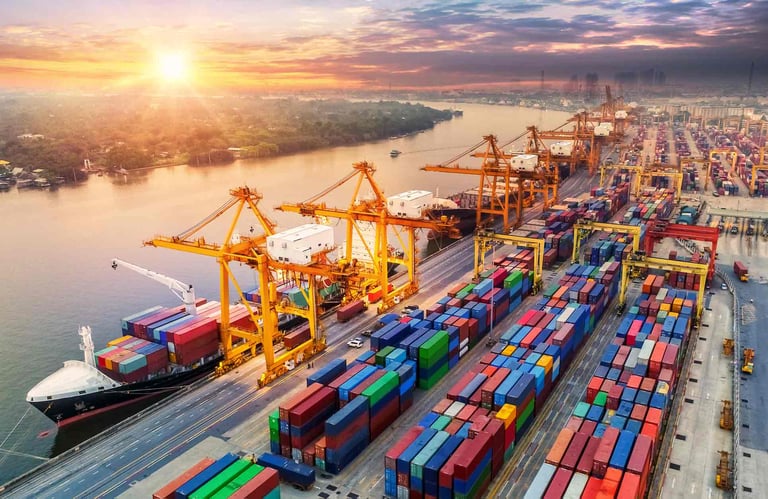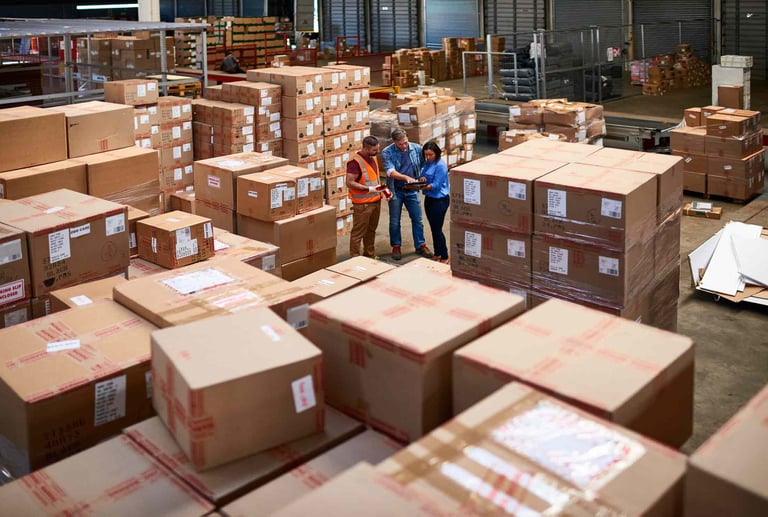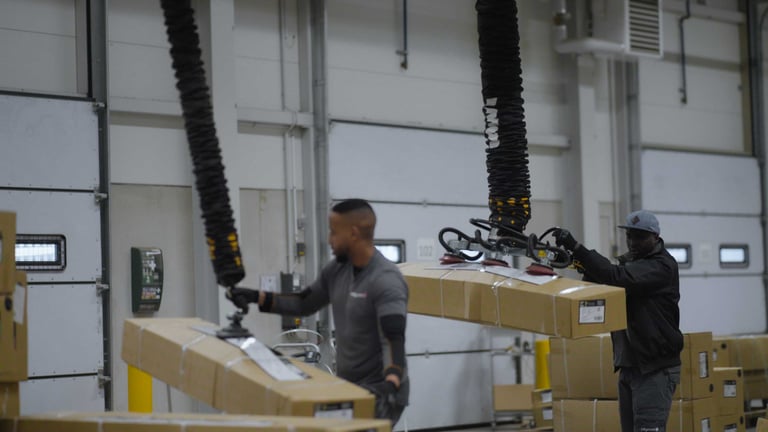Top logistics trends in 2024: The top 5 trends in logistics

The logistics industry is constantly changing and adapting to the rapid growth of technology and the need to conserve the environment. For any business to stay ahead of the curve and remain competitive in these times, it must be flexible enough to accommodate the latest technological advancements, new processes, and strategies to succeed.
Logistics technology will continue to expand and grow, making the logistics industry more agile and reliable. Here are some top trends to watch that will shape the future of the logistics industry.
Supply Chain Agility
Supply chain agility remains one of the focuses of logistics trends in 2024 as businesses strive to satisfy the ever-increasing demand for products and services enabled by digitalisation. Agility will enable businesses to quickly and efficiently respond to fluctuations in supply and demand while also reducing costs and increasing efficiency. It is an essential part of retaining a competitive edge in today's ever-changing market. Cutting-edge technology has helped stabilise the industry by avoiding bottlenecks despite world conflicts and other global events that can have an impact.
Organisations with excellent supply chain agility are better prepared to adjust their products and services to meet customer demands. An organisation should be able to make fast decisions based on new trends and customer preferences and respond to unseen disruptions quickly. Also, supply chain agility allows organisations to manage their stocks better, minimise costs, and increase their profits. Organisations should acquire flexible and collaborative strategies for their operations to achieve supply chain agility. Identifying and responding to changes in demand as quickly as possible is one of the key elements of supply chain agility that requires an in-depth knowledge of customer needs and market and technological trends.
Another important element of supply chain agility is the ability to lower the number of disruptions to the supply chain. For this, an organisation must adopt a proactive approach to risk management, including using backup plans, diversifying suppliers, changing how goods are sourced, and other strategies to counter unexpected disruptions. Companies must also be well prepared to find new solutions when disorders occur so that they can have minimal effect on their operations and customers’ needs. Additionally, investing in new technologies and innovations is important to supply chain agility.

Automation
Automation has become widespread in logistics, changing how the industry operates in its day-to-day activities. It’s been a trend for years now and will still continue to be a logistics trend in 2024. According to Garnter, the key trends in technology can be categorised into two broad areas: first, the imperative for supply chain leaders to utilise emerging technologies for managing and safeguarding their businesses; and second, the emergence of fresh opportunities for competitive advantage through the collaborative integration of humans and machines.
With advancements in technology and the growth of e-commerce, the industry is undergoing a lot of transformation to level up with the world by offering the best services and cutting costs. The benefits of automation have been realized compared to the traditional logistical methods, and one of the key benefits is eliminating manual processes. For instance, inbound logistics or manual picking in a warehouse are time-consuming, a health risk, and prone to errors. With the help of these a collaborative integration of humans and machines through automated solutions, errors and fatigue have been streamlined, achieving high accuracy and being completed quickly.
Semi-automated solutions
Manual lifting and moving of heavy loads can be a major hazard and headache for many operations managers in logistics. To reduce this risk and improve efficiency, companies are beginning to invest in semi-automated processes for lifting, allowing operators to move objects of various sizes and weights with precision and speed while massively reducing the risk of injuries. This technology can provide real-time visibility and tracking, improve working conditions, increase safety in the workplace, and ultimately help reduce costs.
However, while automation can be hugely beneficial, it is not always the best way to go, and a full-automated road may be too much of an investment for some companies. Therefore, semi-automated processes for lifting are a great alternative for many companies to overcome manual material handling challenges in their operations.

Green logistics
Green logistics is a business idea that encourages businesses to minimise their pollution to the environment and, at the same time, improve their operational efficiency. The objectives of green logistics are to reduce gas emissions, conserve resources, and implement waste management policies to help save the environment while still offering customers satisfaction. To keep up with the latest trends of logistics, businesses should consider green logistics to help reduce their environmental footprint.
Green logistics aims to lower energy use, waste production, and the use of hazardous materials to lower the environmental impacts. With 24% global CO2e emissions attributed to the transport and logistics sector, action needs to be taken. Transportation route optimisation is one of the essential elements of green logistics. Finding the most effective routes necessitates using highly developed transportation management systems that analyze traffic patterns, weather conditions, and the weight and amount of goods. The carbon footprint of transportation and fuel usage can be decreased by shortening the distance that commodities must travel. If collective effort is not made and effective measures not implemented, the industry runs the risk of making the European Environment Agency prediction of global logistics being responsible for 40% of global carbon emission by 2050.
Another meaningful way green logistics can conserve the environment is by using electric and alternative fuel vehicles. Fossil fuels significantly contribute to air and water pollution, and the transportation industry contributes significantly to greenhouse gas emissions. The environmental effect of transportation can be considerably decreased by switching to alternative fuels like biodiesel, electric, and hydrogen vehicles. The environmental effect of storage and handling operations can be minimised using energy-efficient facilities, recycling, trash reduction initiatives, and sustainable packaging techniques.
Finally, green logistics also involves the education and engagement of all stakeholders, from shareholders to suppliers, customers, and employees. This ensures that companies understand and embrace green logistics and make sustainability a crucial part of their corporate culture by educating employees about the importance of environmental preservation.
Supply chain visibility
Visibility of the supply chain is the capacity of businesses to trace the movement of their goods from suppliers to customers from start to end. This is crucial for companies to keep track of the performance of their suppliers, guarantee the quality of their goods, and streamline operations. Companies can fully understand the whereabouts of their products and materials thanks to supply chain visibility, which also empowers them to decide how to optimise their supply chain procedures.
Visibility into the supply chain has many advantages, including a lower chance of product recalls, lower production costs, and higher customer satisfaction. For instance, businesses can find areas where they can streamline operations, cut expenses, and boost their bottom line by tracking the movements of their items. This is realised by identifying leakages in the supply chain, working on them to reduce waste and inefficiencies, and optimising the flow of products and materials.
Make informed decisions with real-time supply chain visibility
Real-time supply chain visibility will also enable businesses to reduce their costs by better identifying and utilising the most efficient routes. Additionally, businesses will be able to use this information to better manage their inventory and ensure that their stock is at the right level at the right time. By having an accurate and up-to-date view of the supply chain, businesses will be able to make informed decisions and better anticipate customer demand.
In the years to come, supply chain visibility will become an essential part of logistics. Businesses that can leverage this data to improve their operations and better meet customer demands will be well-positioned to succeed in an increasingly competitive market.
Labour Shortage
As the logistics industry continues to grow, a looming challenge is the shortage of labour resources. In the US alone, it’s anticipated that by 2024, there will be 300 million online shoppers, constituting approximately 91% of the population. This increase in e-commerce is putting significant strain on the logistics industry, which is has already been struggling with labor shortages for several years. With the increasing demand for delivery and shipping services, the demand for labour is becoming unsustainable.
This is evident in the static that nearly 4 in 5 (77%) (ManpowerGroup) employers are struggling to fill job vacancies, that is the highest figure since 2006. Additionally, the number of employees reporting labour shortages has more than doubled since 2015 , reaching 38%. . The world is facing a growing shortage of essential resources such as skilled labour, equipment, and technology, making it difficult for logistics companies to keep up with the demand. This shortage has significantly affected the supply chain, causing delays, increased costs, and low efficiency.
The logistics industry’s main challenge today is the shortage of skilled labour
There have been an increased number of logistic sectors through e-commerce, pushing high the demand for logistics workers. Still, the supply of qualified workers has mostly remained the same. The logistics workers’ job market has become very competitive with the increased shortage, leading to higher salaries and benefits packages. As a result, many organisations face the challenge of finding and retaining skilled workers due to the high costs they must incur to keep employees.
To help address this logistics trend and challenge, logistics organisations are increasingly leveraging advanced technologies and solutions, such as vacuum lifting solutions. Vacuum lifting solutions provide a cost-effective way to move large and heavy items, eliminating the need for manual labour or multiple people to lift and move objects. Not only does this increase efficiency by reducing the need for two-person lifts will also help companies increase the speed of the process, and save time and money while maintaining their productivity goals.
Conclusion
Logistics trends in 2024 are expected to evolve more to cope with global economic and technological advancements. Logistics industries will focus more on automation, labour shortage and real-time tracking for efficient supply chain management. Adopting new technologies like autonomous vehicles will be critical for logistics companies to remain competitive globally, where every other company wants to outdo the other. In addition, organisations will need to focus on sustainability and environmental initiatives to ensure the industry’s long-term health and commitment to preserving nature. The logistics industry will rapidly evolve, and the companies adapting to these trends will probably have optimal productivity.